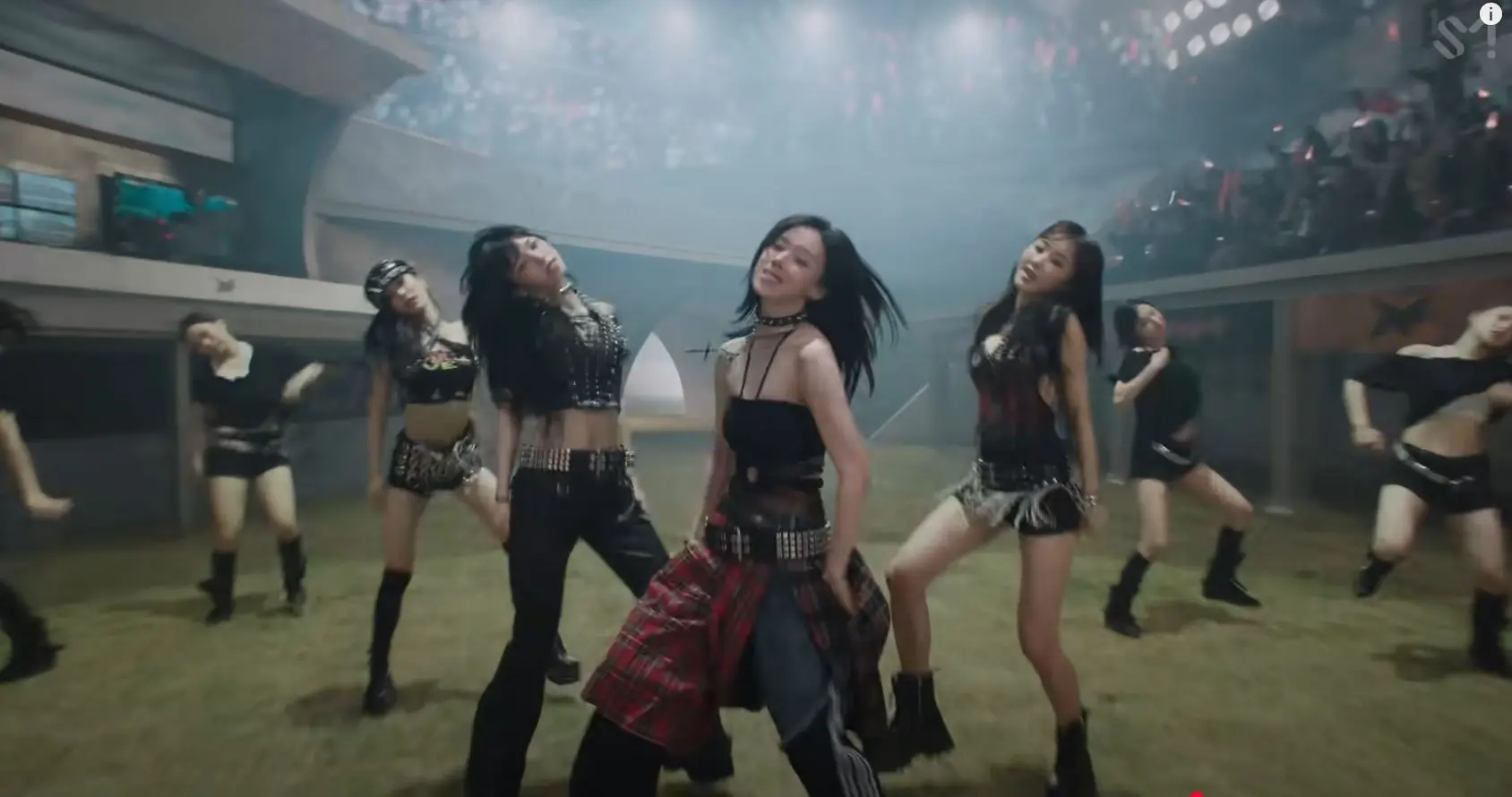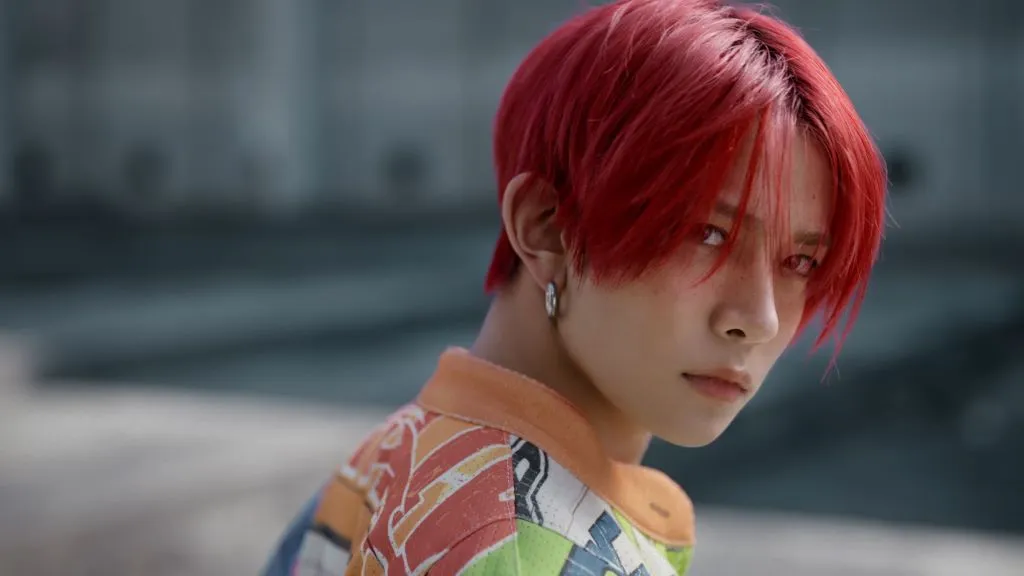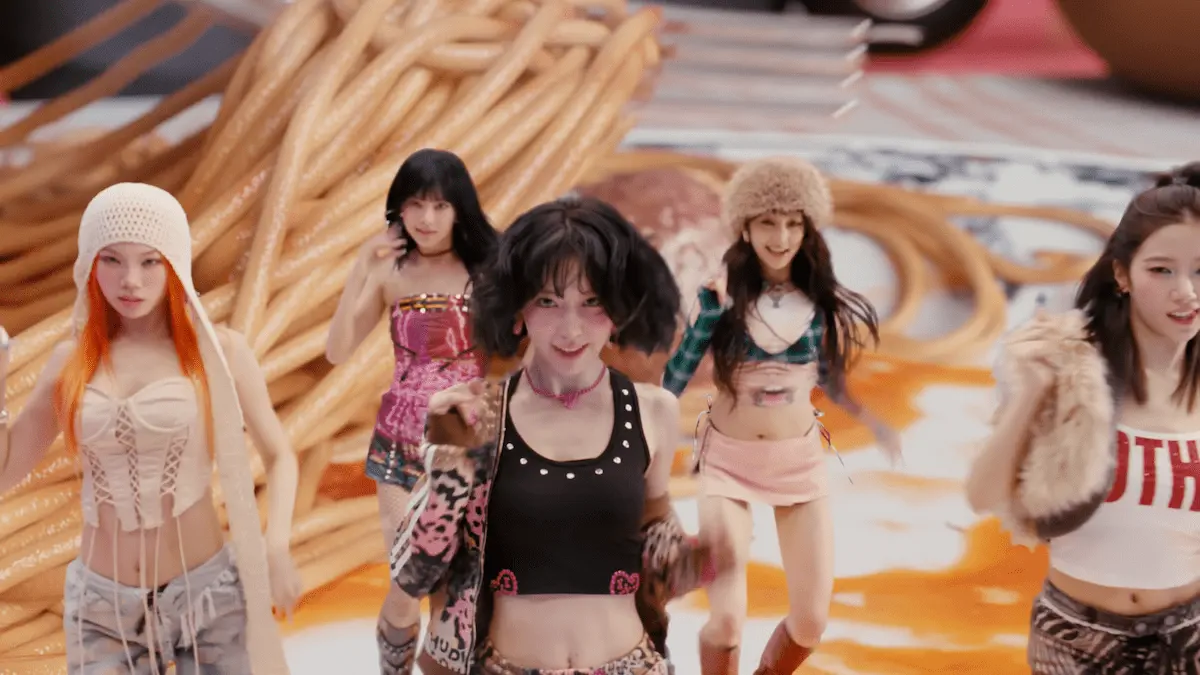[aespa] - 'Rich Man': How Four Women Redefined Wealth in K-Pop (MV Explained)
Picture this: your mom tells you to find a rich man. You look her dead in the eye and say, "Mom, I already have everything." That's not just sass—that's the entire thesis of aespa's **"Rich Man"** in one sentence. This isn't another K-pop song about wanting luxury. It's about **being** the luxury. And the music video? It strips away every distraction to make one point: confidence doesn't need props. Let me show you how aespa built a manifesto out of concrete floors, leather jackets, and the most direct eye contact in K-pop history.

Source: Official aespa YouTube (© SM Entertainment)
Table of Contents (Find Your Story)
Quick Summary: The Vibe Check
“Rich Man” is aespa’s declaration of self-authorship, swapping maximalist hyperpop for grounded dance-rock. The MV features stark, industrial sets and leather-heavy styling, intentionally avoiding opulence to prove that the members themselves are the ultimate luxury. The core message is that true ‘wealth’ is non-monetary—it’s competence, emotional clarity, and the power to set one’s own standards, making this the most mature and significant statement in their post-Kwangya era.
Credits
The Story You See on Screen
The MV's story is deliberately anti-narrative; its plot is one of **posture and conviction**. From the opening frame, the setting is a highly minimalist, industrial warehouse space. This visual choice immediately establishes the thesis: there is no fictional world, no avatars, and no complex lore to distract from the members. The "story" is simply aespa occupying a barren space with unshakeable confidence, turning concrete and chrome into a throne room.
The visual flow is built on a sequence of powerful **frontal assaults**. The camera uses repeated close-ups and low-angle shots to deliver direct eye contact, making the viewer feel like they are receiving a personal manifesto. There is no attempt at conventional 'beauty' shots; instead, the visuals favor sculptural precision. The lighting is often harsh and focused, carving out the members' silhouettes against the darkness, further stripping away any unnecessary ornamentation.
The MV culminates in the powerful, minimal choreography sequences. The focus shifts from the individual member's gaze to the collective's unified movement. This progression, from individual assertion to collective dominance, concludes the visual story: **aespa is no longer defined by a world they inhabit, but by the undeniable strength they possess.** This stripped-down approach is the greatest visual pivot in their career, moving their story from 'fantasy' to 'reality.'
Lyrics & meaning
Lyrical Story & Narrative
This song's narrative completely shatters the typical 'love song' frame, opening up a new genre: the **'Self-Declaration'**. The speaker isn't a passive voice yearning for someone or something; they appear as a fully **self-contained entity** whose value is already established. The core plot revolves around the speaker's response to societal pressure—be it finding a wealthy partner or meeting external standards of success—by confidently asserting, "I already have everything." The lyrics position the **internal, psychological state of the speaker above any external, material condition.**
The structure of the lyrics is centered on **'redefining the question'**. When the world (or a critic) implicitly asks, "What do you *possess*?", the speaker chooses to list their **actions (Verbs)** rather than their possessions (Nouns). Verbs like 'Own,' 'Carry,' and 'Decide' are put forward as intangible assets of **'Sovereignty' and 'Competence'**. In this context, the speaker’s wealth isn't measured by a bank balance; it's defined by their **ability to autonomously sculpt their own life.**
When the phrase 'Rich Man' repeats in the hook, it's not a reference to a wealthy male figure, but a brilliant act of **internalizing the concept of 'richness' itself**, detaching it from gender and external requirements. This narrative encourages the listener to respect external advice (filial) while ultimately **self-authoring (self-authorship)** their own criteria for success and satisfaction. It's a highly intelligent form of storytelling that substitutes the common K-Pop narrative of 'Success' with the deeper narrative of **'Self-Actualization'**.
The Intent Behind the Hook & Cultural Nuance
To understand why this song is a cultural landmark, we must connect the hook’s intention to the broader Korean social context. The phrase **'I am a rich man'** is an economic strategy of declaring **'Non-Monetary Wealth'**. The 'Rich' here symbolizes **Time Sovereignty** (the power to control one's schedule), **Emotional Clarity**, and **Unwavering Standards**. The lyrics successfully elevate the **psychological capital** that the contemporary generation—especially in Korea—craves just as much as, or more than, material success.
Subtle **wordplay** and **tonal strategies** are hidden in the lyrics. The ambiguous use of 'you' allows the listener to interpret the target as either **'societal pressure'** or **'one’s own internal self-doubt'**. This intentional ambiguity deepens the impact. Furthermore, the speaker's seemingly dismissive attitude toward needing a 'strong mentality' (delivered with a confident, almost dry tone) implies that resilience isn't a special 'effort' or 'mode' that one acquires, but their **'default firmware'**. This sophisticated swagger avoids preaching, instead showcasing a confidence that triumphs over problems through sheer competence.
Finally, the **intertextual analysis with aespa’s own lore** is crucial. If early aespa proved their power by battling in an external world (Kwangya), 'Rich Man' internalizes that entire **external narrative (lore)** into a **'lived standard'**. The implication is that the journeys, the battles, and the connection with their avatars have all been accumulated into the members' **intangible wealth of skill and self-assurance**. The lyrics thus blend contemporary cultural demands with the artist's career arc, transforming the song into a **generational manifesto**.
Curator's Deep Dive: A Multi-Layered Analysis
1. Fashion Deconstruction: More Than Just Clothes
The styling in "Rich Man" is a deliberate rejection of over-the-top, logo-driven luxury in favor of **Industrial Chic** with a military-esque undertone. This aesthetic choice is fundamental to the lyrical theme, arguing that **opulence is a distraction; self-command is the true luxury**. The primary uniform is dominated by **black leather and metallic silver hardware**.
The leather acts as a visual metaphor for **armor**—a uniform of autonomy that protects their self-defined value. It suggests a readiness for a self-made journey, not a pampered existence. The minimal silver hardware (chains, spikes, industrial belts) provides aggressive texture and contrast, aligning with the track's rock elements, but consciously refuses to dominate the frame [01:10]. This reinforces the idea that the **wearer is the spectacle**, not the designer item.
The use of minimalist tailoring, such as **Karina's leather halter top** and **Winter's cropped jackets**, relies entirely on the members' powerful silhouettes, aligning with the "less is more" philosophy often seen in high-end streetwear and independent luxury. This styling communicates self-command more effectively than any diamond ever could, cementing the thesis that they are **"Rich" in competency and control**, not just consumer goods.
2. The Sound: A Producer's Perspective
The track is engineered by **Cody Tarpley** and **Ryan Jhun**, signaling an intentional pivot from their signature hyperpop. The sonic shift favors **clarity over density**. The sound is built on a potent blend of: **Rock textures** (crunchy guitars, live-leaning drums carrying the chorus) and a **Hip-hop chassis** (a thick sub-bass and trap-adjacent hats driving the verses).
The genius lies in the **restraint**. There are no tempo fakes, mid-song scene changes, or maximalist synth stacks. The production creates tension not through layering, but by the calculated acceleration of **Hi-hats** and the thinning of the low-end in the pre-chorus, creating intentional headspace before the full band weight hits in the chorus. This makes the **unvarnished vocal delivery** (a clear technical choice) the main event.
Micro-moments define the production: The clean guitar riff opening (0:00–0:15) sets a tone of calculated aggression. The weight of the **808 body** drives the verses, giving them a grounded, muscular feel. Even the vocals are mixed lower and drier in the verses, only cutting through sharply in the chorus. The bridge reset (around 02:40) strips the track back to an almost dry vocal over a minimal beat, confirming that the confidence lies in the performance, not the production tricks.
3. Cinematic Language: Reading Between the Frames
The MV is a masterclass in **Industrial Austerity**. The directors chose **warehouse bones** and a **monochrome palette** to eliminate visual noise. This forces the viewer's focus onto the members' posture and gaze. The cinematic language is not passive; it is confrontational, challenging the audience to accept the members' self-declared value.
The key technique is the repetitive use of **low-angle shots (Low Angle)** throughout the MV [00:45]. By shooting up at the members, the camera amplifies their **physical and thematic dominance**, asserting their authority and eliminating any possibility of the viewer being a passive voyeur. This visual grammar of **heightened perspective** is a deliberate choice to align with the lyrical theme of 'self-sovereignty.'
The lack of frenetic cuts and the tendency to **hold** on the members' **frontal gaze** (Karina at 00:50) confirms the thesis of the song. The MV uses **tight framing** and high-contrast lighting to eliminate all peripheral information. This visual precision, coupled with the strategic absence of hand-held camera work, creates an atmosphere of unshakeable control, asserting that aespa’s power is now **internal, human-first, and unembellished**.
4. Choreography & Performance: The Story in Motion
The choreography, set by an international team, is a physical manifesto: **Power Without Performance**. The movement is heavy, weighted, and deliberate, contrasting sharply with the fluid, highly complex movements seen in many of their 4th generation contemporaries.
The choreo's grammar is built on **stance and punctuation**. Key moments utilize **wide-based, grounded stances** (e.g., Ningning's base during her verse at 01:25) with minimal upper-body motion. This body language is a physical manifestation of the lyrical theme of **autonomy**—a body perfectly balanced and unmoving cannot be easily swayed. The single most impactful move is the collective **Walk** [00:40]: forward, unhurried, and unapologetic, signaling that confidence enters with a measured pace.
Compared to the more frenetic, narrative-driven choreography of their debut contemporaries like NewJeans' 'Hype Boy' (which is flow-based and conversational), aespa's 'Rich Man' opts for **Stately Dominance**. The synchronized **180-degree turns** and deliberate **pauses** (around 02:00) act like bold punctuation marks in a manifesto, showing **mastery and timing as dominance**. The choreography's restraint elevates the members' **presence**, making it legible and impactful even on a small phone screen.
Fan Takeaways
**“This sounds like them.”** Fans who wanted less concept fog and more member-forward delivery feel seen. MYs (aespa's fans) recognized this release as the group finally shedding the narrative weight of the Kwangya lore to stand on their own strength, which is incredibly validating. The shift from AI-focused concept to human-first command is exactly what the fandom needed to secure the group's legacy.
**“It grows with repeats.”** The minimal frame rewards re-listens; the musical and visual details (the subtle guitar grain, the confident low-angle shots) surface rather than shout. This slow-burn confidence is a welcome change from the high-octane "sugar rush" of previous releases, which, while powerful, could feel overwhelming. It gives fans something mature to chew on, proving aespa’s longevity is based on craft, not just trends.
Ultimately, **"Rich Man"** is special because it gave fans a relatable and aspirational theme. The song essentially provides a mantra for the modern era: **"You are already enough."** In a society consumed by measuring success externally, aespa offered the ultimate cheat sheet—claiming emotional and professional wealth as self-defined. This sentiment is highly shareable and creates a deep, emotional bond between the artists and the listener that goes beyond just liking the music.
Frequently Asked Questions (Q&A)
Is "Rich Man" aespa's departure from their signature sound?
It steps away from hyperpop maximalism while keeping aespa’s appetite for concept. Think of it as tightening the toolkit: fewer layers, stronger core. The foundation is still futuristic, but the expression is grounded in Dance-Rock and Hip-Hop textures.
Why is the MV so minimal compared to previous releases?
Minimalism is the message. If the lyric says value is internal, the frame’s job is to get out of the way. The industrial austerity, black leather styling, and low-angle camera grammar prove the point: true power requires no external props or CGI spectacle.
What does "I am a rich man" actually mean?
It claims non-monetary wealth—time, standards, competence, emotional steadiness—and retools a gendered phrase into a badge of authorship. In short: complete, capable, self-sufficient.
Sources & Technical Data
Credible Sources
Production Credits
- Composers: Cody Tarpley, Rachel Kanner, Ben Samama
- Producers: Cody Tarpley, Ryan Jhun
- Label: SM Entertainment




Comments